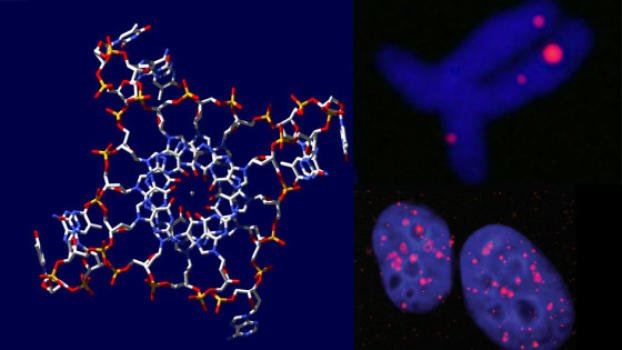
Scientists at Cambridge University working in human cells say they have seen four-stranded DNA for the first time.
DNA, which carries our genetic code, is more familiar to us as a double helix.
But researchers tell the journal Nature Chemistry that the “quadruple helix” is also present in our cells, and in ways that might possibly relate to cancer.
They suggest that control of the structures could provide novel ways to fight the disease.
“The existence of these structures may be loaded when the cell has a certain genotype or a certain dysfunctional state,” said Prof. Shankar Balasubramanian from Cambridge’s department of chemistry.
“We need to prove that; but if that is the case, targeting them with synthetic molecules could be an interesting way of selectively targeting those cells that have this dysfunction,” he said.

It will be exactly 60 years ago in February that James Watson and Francis Crick famously burst into the pub next to their Cambridge laboratory to announce the discovery of the “secret of life”.
What they had actually done was describe the way in which two long chemical chains wound up around each other to encode the information cells need to build and maintain our bodies.
Today, the pair’s modern counterparts in the university city continue to work on DNA’s complexities.
Shankar Balasubramanian’s group has been pursuing a four-stranded version of the molecule that scientists have produced in the test tube now for a number of years.
It is called the G-quadruplex. The “G” refers to guanine, one of the four chemical groups, or “bases”, that hold DNA together and which encode our genetic information (the others being adenine, cytosine, and thymine).
The G-quadruplex seems to form in DNA where guanine exists in substantial quantities.
And although ciliates, relatively simple microscopic organisms, have displayed evidence for the incidence of such DNA, the new research is said to be the first to firmly pinpoint the quadruple helix in human cells.
The team, led by Giulia Biffi, a researcher in Shankar Balasubramaninan’s lab, produced antibody proteins that were designed specifically to track down and bind to regions of human DNA that were rich in the quadruplex structure. The antibodies were tagged with a fluorescence marker so that the time and place of the structures’ emergence in the cell cycle could be noted and imaged.
This revealed the four-stranded DNA arose most frequently during the so-called “s-phase” when a cell copies its DNA just prior to dividing.
Prof. Shankar Balasubramaninan said that was of key interest in the study of cancers, which were usually driven by genes, or oncogenes, that had mutated to increase DNA replication.
If the G-quadruplex could be implicated in the development of some cancers, it might be possible, he said, to make synthetic molecules that contained the structure and blocked the runaway cell proliferation at the root of tumors.
“We’ve come a long way in 10 years, from simple ideas to really seeing some substance in the existence and tractability of targeting these funny structures,” he said.
“I’m hoping now that the pharmaceutical companies will bring this on to their radar and we can perhaps take a more serious look at whether quadruplexes are indeed therapeutically viable targets.”